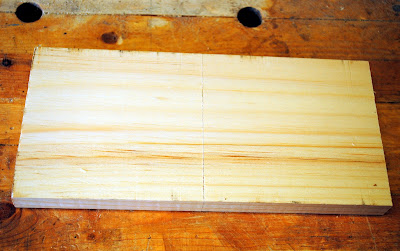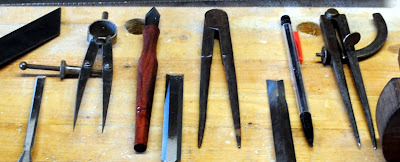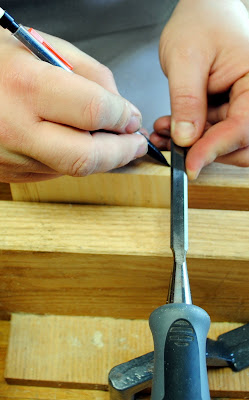Continuing along my discussion layouts for dovetail joints. If you are just joining the madness and want to catch up with whats been said already, all the posts have been collected HERE.
Theres a line of wisdom that says "Dont miss the forest for the trees" meaning dont get so caught up in the details of a thing that you miss the big picture. I think that this is an easy thing to do as an eager and budding dovetailer. You are focused on the angles, focused on the symmetry, thinking about splitting the line with your saw blade, thinking about paring those cuts to the perfect fit, and anything else you want to pile on with.
In the midst of all those things its understandable when you miss out on something that is very elemental to the difference between good wood working and fine woodworking, you fail to pay attention to the wood itself. Especially where the dovetail joint is going to show, paying attention to the grain of the wood and getting it to match up and flow around the corner can be one of those subtle differences that make all the difference in the world.
Grain matching may seem like it has little place in the discussion of dovetail layouts. Some may think its a subject for talking about alongside fine design and refined woodworking techniques. But I have to say I wish someone had clued me in on such things sooner in my own woodworking. Grain matching is never a showstopper of a technique, not like book matching can be, but its effects can be powerful in the way a piece flows together.
If you were to build two boxes, using the same exact proportions, size, wood, everything, with the only difference being you utilized grain matching techniques on one box and paid zero attention to such things on the other. If you were to then show those two boxes to a multitude of strangers and ask them which box they liked better, I know the grain matched box would win. But the more interesting thing is Ill bet those people who picked it wouldnt be able to explain exactly why. The technique is simple and just leads to a more pleasing flow through a piece. It helps tie one board to another visually, and is something that is always important o consider in all of your design and layout endeavors, dovetails included.

It starts with the board, here you can see I re-pieced these sections together after cutting them. Take a second and notice how, even on this standard pine board, the grain has a real unique beauty to it, with a lighter band above and almost a horizon towards the bottom third. In my mind I can almost picture a landscape in this simple board and the dark band of the horizon where the sky and the earth meet ties it together. It would be a shame to lose this effect by not paying attention to the flow and rolling one board upside down, or even worse, flipping it over front for back.
But how do you keep track of such things? With a simple triangle pencil mark my friends.
Now you have to know and pay attention to the triangle as you layout and cut the boards, taking care that the faces of the boards and orientation remains the same. It really isnt any extra work, its more like a little extra mindfulness that pays off in big dividends later.
Here you can see that the triangle helps track the board through the corner and helps me keep my orientation throughout the process. the mark can also be helpful keeping straight which corner belongs to which so you always get your pins or tails transferred to the correct other board, because even dovetailing a box with four corners, you will not draw the triangle the same way four times in a row. Each one will be distinct in how it lines up and that will help you keep track of the four corners.
Heres a close up of the way the grain carried though, it is interrupted by the joint itself but I think it adds a little drama to the landscape we pictured. Especially once we plane off all the pencil marks.
Doesnt that have a nice and finished looking appeal to it? When you are using this technique for a box like project its best to chase the grain from one side, through the front, to the other side, leaving what is to be the backside to be the grain mismatch. Thus I might cut my stock like this:

As a quick finish up before we start to get into covering the actual process I use to do different layouts I want to take a quick look at the handful of tools I put to use doing this.
I like to use a bevel marking gauge for setting my angles. One could certainly use a Dovetail marker it they like butI like the little bit of human error that comes with using this tool. It helps me know my dovetails were laid out and cut by hand and to me thats important.
If youre gonna use a bevel marking gauge like me, I highly recommend looking around to find an older Stanley type with the thumb lever to it. It is a million times better than newer versions with a wing nut. I found mine in an antique store a couple blocks from our apartment building, but Im sure if you look around eBay you can find your own.
I also like to use a small try square, or I have been known to use a 6" combination square from time to time as well. I find the smaller square is easier to control when marking on the edge of the board.
Ye Old Marking Gauge is very important to the process, It is the one layout tool you do see in everyone of the "3 minute dovetail" videos that is out there. I have a little bit of a problem in that if I see an old wooden one in good shape I always find myself buying it. I like to use the pin gauges on hardwoods and the blade gauges on soft woods, but if you only have one type, dont let that stop you from moving forward.

I use dividers to transfer measurements and of course a marking knife or a mechanical pencil to make the lines Ill eventually cut. I think I may be a little handicapped when it comes to using a marking knife, it always seems to give me issues, but I keep using it knowing someday my hands and head will figure it out. By default I end up falling to the mechanical pencil, not really a bad back up in fact it works quite well and always has for me. I think I may have decided to conquer the marking knife because I saw all the cool kids using them and I didnt want to be left out, maybe its just the style that doesnt jive with me. In the end, you should always use what works and gives you good repeatable results.

Now I know a chisel isnt your standard layout tool, but I do use them quite a bit in my layout. I can get out the folding ruler, dial in the dividers to a 1/4" mark it on the board and then finish the line with my bevel gauge or square, or I can use the standard width measurements of my chisels as my guide. Often for edge work when cutting out the tails first, I can just mark right off the chisel itself.
 |
| Marking directly off a 3/8" chisel. |
That should catch us up to begin talking about the actual process for several different layouts, next post I will break down the method I learned from an article written by Frank Klausz that gave me the understanding I needed to start dovetailing again after many failed attempts.
Cheers
Oldwolf






 As a quick finish up before we start to get into covering the actual process I use to do different layouts I want to take a quick look at the handful of tools I put to use doing this.
As a quick finish up before we start to get into covering the actual process I use to do different layouts I want to take a quick look at the handful of tools I put to use doing this.






No comments:
Post a Comment